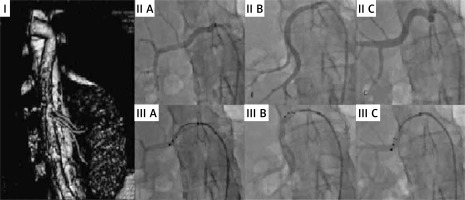In the majority of patients with resistant hypertension, increased activity of the sympathetic system is observed. Denervation of renal arteries (RDN) is one of the methods that may lead to reduction of blood pressure [1, 2]. Although the ESC/ESH guidelines do not recommend using invasive methods in the routine treatment of hypertension, current Polish Society for Hypertension guidelines published after the SPYRAL and RADIANCE trial publications emphasise the effectiveness and benefits of this form of treatment [3, 4]. Currently, it is recommended that RDN is classified and performed only in highly specialised centres [3, 4].
A 62-year-old patient was admitted because of increased values of blood pressure (average blood pressure (BP) 170/100 mm Hg) despite taking five antihypertensive drugs in maximum doses: carvedilol, doxazosin, valsartan, hydrochlorothiazide, and nitrendipine. The patient’s history included: left-sided nephrectomy because of renal cell carcinoma (15.03.2000), two strokes, type 2 diabetes, and obesity (body mass index (BMI) 45 kg/m2). The reasons of secondary hypertension were excluded. Ambulatory blood pressure monitoring (ABPM) confirmed inappropriate control of BP (average 172/96 mm Hg: day average 179/102 mm Hg, night average 156/83 mm Hg). An angio-computed tomography (CT) scan revealed three separate, equivalent arteries supplying blood to the right kidney (Figures 1 I, II). The arteries ran parallel in the proximal and medial parts (the upper artery – length 83 mm, diameter 4.5 mm, the lower 85 mm and 4.3 mm, the medial 110 mm and 4.0 mm, respectively). The patient was qualified for RDN. The denervation was performed in three right arteries with the use of a multielectrode catheter EnligHTNTM (St. Jude Medical). In every artery two radiofrequency applications were done (eight ablation points altogether) (Figure 1 III).
Figure 1
Three equivalent arteries leading to the right kidney in CT-scan (I) angiography (II) and renal denervation in separate arteries (III). A – upper, B – lower, C – medial

The pharmacological treatment was maintained throughout the follow-up period. During control visits after 1 and 6 months the patient had satisfactory control of BP (mean BP 136/77 mm Hg, 124/65 mm Hg, respectively), and no episodes of hypotension were observed nor biochemical features of deterioration of kidney function. Seven months after RDN the patient was admitted to the hospital because of a collapse. Low BP values were found on admission (90/45 mm Hg); biochemical test results showed no abnormalities. ABPM revealed low BP values (day 105/56 mm Hg, night 111/59 mm Hg). The doses of antihypertensive drugs were reduced, with normal BP values observed. One year after the procedure ABPM showed a day average of 150/87 mm Hg and night average of 137/70 mm Hg. The drug dose was then increased. During subsequent outpatient check-ups 2 and 3 years after denervation good control of blood pressure was observed (mean BP 139/74 mm Hg, 137/80 mm Hg, respectively). However, during the check up after 4 and 5 years increased BP values were observed again (day average 150/95 mm Hg, night average 142/90 mm Hg). No deterioration of kidney function in lab tests and ultrasonography exam was observed. The antihypertensive drug doses were increased again.
In the beginning of application RDN was performed only in patients with good renal function and renal arteries without atherosclerotic lesions. In subsequent studies, RDN was performed also in patients with more complex anatomy of renal circulation [4, 5]. The described patient is a representative of such population. RDN in three arteries supplying blood to the solitary kidney had no complications. Immediately after the procedure BP was significantly reduced. The full antihypertensive effect was observed more than 3 years after RDN. Unfortunately, after 3 years the BP values increased, requiring intensification of the antihypertensive treatment. This might have resulted from the rebuilding of afferent fibres in the renal arteries.








